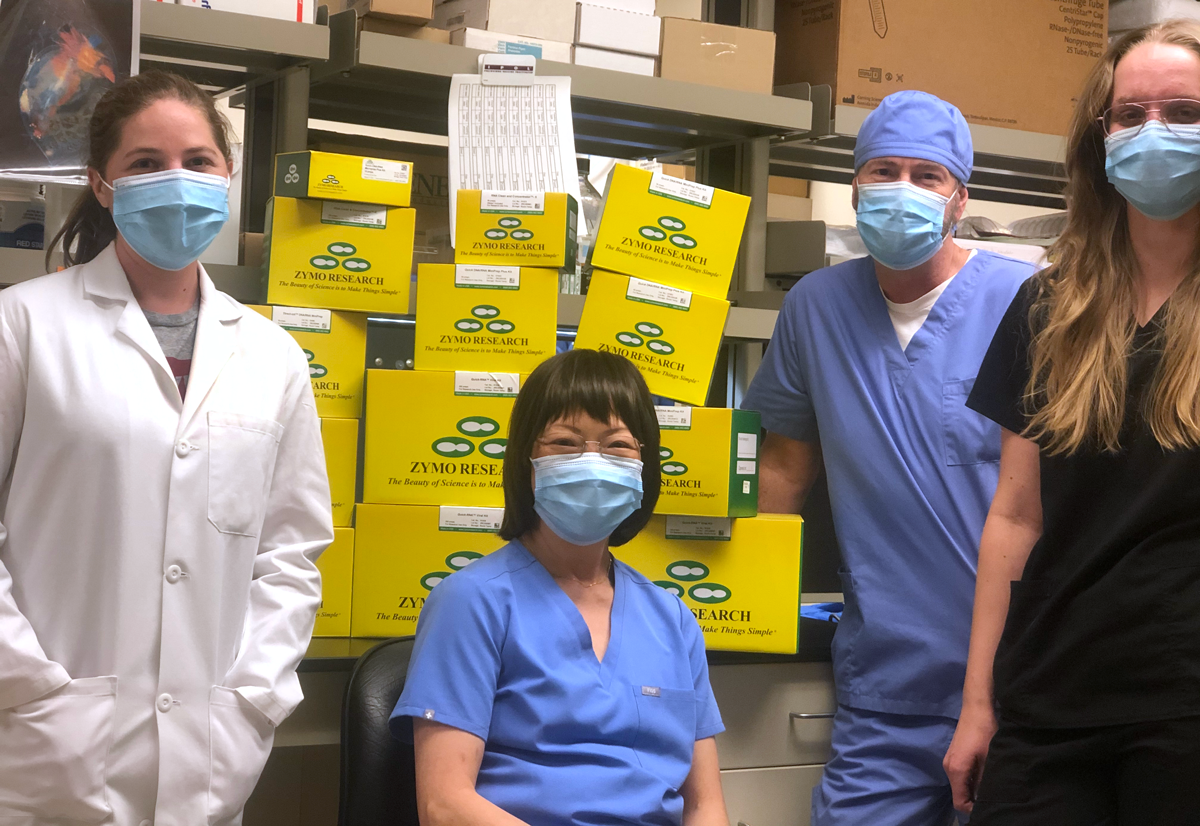IN THE BLOOD: PIONEERING PLASMA TREATMENT FOR COVID-19
One Lab’s Exploration of COVID-19 Treatment
In Albuquerque, New Mexico, while lockdowns were just beginning across the nation, a small team of scientists from the University of New Mexico’s Center for Global Health (UNM CGH) decided to do everything they could to fight the growing pandemic. Under the leadership of Dr. Douglas J. Perkins, this team joined a pilot study to evaluate the efficacy and effects of convalescent plasma (CP) on hospitalized COVID-19 patients. Convalescent Plasma is collected from people who have recently recovered from a disease, in this case, COVID-19, whose blood contains antibodies for fighting that illness. To assess the viability of CP as a treatment for COVID-19, the team conducted quantitative analysis on three factors: Immunoglobulin G (IgG), Neutralizing Antibodies (NAb), and the relation between those two factors and patient viral load.
“There were many unknowns regarding the risk of SARS-CoV-2 infectivity in late February and early March 2020 when this study first began. As such, the handling and processing of infected patient samples was initially a concern.”
- Dr. Ivy Hurwitz
Research Associate Professor, Center for Global Health Department of Internal Medicine, University of New Mexico
The team was the first to report on NAb and IgG levels in donor CP and in recipients before and after transfusion using whole blood and nasopharyngeal samples.
However, being first posed its own challenges. A risk of novel pandemic research is that the infectivity of the studied virus is not fully understood. Research Associate Professor at the Center for Global Health Department of Internal Medicine, Dr. Ivy Hurwitz noted, “There were many unknowns regarding the risk of SARS-CoV-2 infectivity in late February of March 2020 when this study first began. As such, the handling and processing of infected patient samples was initially a concern.”
To offset the risks of working with patient whole blood and nasopharyngeal samples the team adopted Biosafety Level 2+ (BSL 2+) practices, which are meant to protect researchers handling hazardous human pathogens.
Tests to quantify NAb quantities were performed at a BSL-3 testing facility, the same Biosafety level required to work with pathogens such as tuberculosis and West Nile virus.
Finding the Antibodies
However, NAb and IgG levels are only half the story. The team also had to measure viral load before and after the treatment to understand the efficacy of the donated plasma. If the team found viral load tended to decrease after treatment with the donated CP, the study could suggest donated CP as a viable option for treating COVID-19.
Dr. Hurwitz added, “whole blood and nasopharyngeal swabs (NP) were collected from the patients throughout the two-week hospitalization. Whole blood was separated using density centrifugation and SARS-CoV-2 virus RNA was isolated from the NPs in the BSL-2+ facility.”
To quantify viral load, the team used aliquots of whole blood and DNA/RNA Shield transport media, which preserved the nucleic acids in samples while inactivating any latent pathogens. Viral RNA was isolated using the Quick-RNA Viral Kit, and viral load was quantified using RT-qPCR using the CDC 2019-nCoVEUA-01 diagnostic panel.
The team found that as NAb concentrations in donor plasma increased and viral load in the patient tended to decrease, suggesting that donated plasma therapy had some viability as a treatment.

The Takeaway
While the team found an inverse relationship between Neutralizing Antibody concentrations in donor CP and patient viral load, it also noted that donor convalescent plasma did not always test for high quantities of NAb.
“We found that the median NAb titer in donor units used in this study were low. We saw an inverse relationship between NAb titers and viral loads across sampling days following CP transfusion in recipients. A similar inverse correlation was also present between IgG levels for SARS-CoV-2 S1 subunit of the spike protein and viral load,” Dr. Hurwitz reported.
The team’s findings suggest that donor plasma should first be screened for NAb and IgG quantities prior to administration of donor CP to ensure the efficacy of the treatment on COVID-19 patients.
“Although the limitation of our work is the small sample size, our results raise concerns over the administration of CP to large numbers of patients with COVID-19 without first screening donors or plasma for NAb and IgG activity. Our findings would corroborate the variability seen with CP therapy for COVID-19. The implication of this work is the importance of measuring NAb titers in donor plasma prior to infusion.”
The Future
The team will be continuing and expanding their research on COVID-19: focusing on the reaction of the immune system from patients with severe cases versus non-severe, in order to identify potential novel therapeutic targets for further investigation within clinical trials, again implementing DNA/RNA Shield and the Quick-RNA Viral Kit in their workflow.
Additionally, the team has been supporting the medical community by decontaminating N-95 respirators to make them safe for reuse to fight PPE shortages and keep frontline workers safe, as well examining fomites to determine how SARS-CoV-2 spreads in hospital settings.
When asked what this important work means to them, the team remarked: “It has been an honor to work with such diverse and dedicated researchers during the pandemic. Another rewarding experience of conducting COVID-19 research has been the contribution to treatment efforts for individuals suffering from this devastating disease. We are hopeful that treatment for COVID-19 will continue to improve the clinical outcomes in patients and ease the burden this pandemic has placed on the global community.”
*Update: As of July 2021, the team has published their latest research on Presence of SARS-CoV-2 fomites in a university hospital setting. 1
Learn More About Zymo Research’s COVID-19 Testing Solutions:
Learn moreReferences:
1. Bartlett, Christopher, et al. "COVID-19 global pandemic planning: Presence of SARS-CoV-2 fomites in a university hospital setting." Experimental Biology and Medicine (2021). https://journals.sagepub.com/doi/pdf/10.1177/15353702211024597


